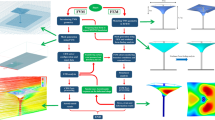Abstract
A multiscale analysis is presented for the performance of the hydrodynamic wedge-platform thrust slider bearing where the surface separation is so low that it is comparable with the thickness of the adsorbed layer on the bearing surface. There are the flows of two adsorbed layers and the intermediate continuum fluid flow, which are respectively modeled by the flow equation for nanoscale flow and the Newtonian fluid model. The flow equations are respectively given for the adsorbed layers and the continuum fluid, showing the coupled effect in this multiscale flow. The calculation results show that when the minimum bearing surface separation is below 100 nm, for the medium and strong fluid-bearing surface interactions, the adsorbed layer effect significantly increases the load-carrying capacity of the bearing, and it is more pronounced for smaller bearing surface separations. The multiscale analysis gives the carried load of the bearing much larger than the classical hydrodynamic theory calculation with qualitatively good agreement with the experimental observation, showing the significant contribution of the adsorbed layer in a hydrodynamic bearing with low surface separations.




Similar content being viewed by others
References
O. Pinkus, B. Sternlicht, Theory of Hydrodynamic Lubrication (McGraw-Hill, New York, 1961).
D.Y.C. Chan, R.G. Horn, The drainage of thin liquid films between solid surfaces. J Chem Phys 83, 5311–5324 (1985)
C. Liu, Z. Li, On the validity of the Navier-Stokes equations for nanoscale liquid flows: the role of channel size. AIP Adv 1, 032108 (2011)
G. Chauveteau, M. Tirrell, A. Omari, Concentration dependence of the effective viscosity of polymer solutions in small pores with repulsive or attractive walls. J Colloid Interf Sci 100, 41–54 (1984)
C.E. Brown, D.H. Everett, A.V. Powell, P.E. Thome, Adsorption and structuring phenomena at the solid/liquid interface. Faraday Discussion Chem Soc 59, 97–108 (1975)
F.F. Abraham, The interfacial density profile of a Lennard-Jones fluid in contact with a (100) Lennard-Jones wall and its relationship to idealized fluid/wall systems: a Monte Carlo simulation. J Chem Phys 68, 3713–3716 (1978)
I. Bitsanis, T.K. Vanderlick, M. Tirrell, H.T. Davis, A tractable molecular theory of flow in strongly inhomogeneous fluids. J Chem Phys 89, 3152–3162 (1988)
Y.B. Zhang, Flow factor of non-continuum fluids in one-dimensional contact. Indust Lub Tribol 58, 151–169 (2006)
Y.B. Zhang, The flow equation for a nanoscale fluid flow. Int J Heat Mass Transf 92, 1004–1008 (2016)
O. Atkas, N.R. Aluru, A combined continuum/DSMC technique for multiscale analysis of microfluidic filters. J Comput Phys 178, 342–372 (2002)
J. Liu, S. Chen, X. Nie, M.O. Robbins, A continuum-atomistic simulation of heat transfer in micro- and nano- flows. J Comput Phys 227, 279–291 (2007)
J. Sun, Y. He, W.Q. Tao, Scale effect on flow and thermal boundaries in micro-/nano- channel flow using molecular dynamics-continuum hybrid simulation method. Internat J Num Methods Eng 81, 207–228 (2010)
X. Yang, Z.C. Zheng, Effects of channel scale on slip length of flow in micro/nano channels. ASME J Fluids Eng 132, 061201 (2010)
T.H. Yen, C.Y. Soong, P.Y. Tzeng, Hybrid molecular dynamics-continuum simulation for nano/mesoscale channel flows. Microfluid. Nanofluid 3, 665–675 (2007)
Y.B. Zhang, The flow factor approach model for the fluid flow in a nano channel. Int J Heat Mass Transf 89, 733–742 (2015)
Y.B. Zhang, Modeling of flow in a very small surface separation. Appl Mathe Model 82, 573–586 (2020)
Y.B. Zhang, Lubrication analysis for a line contact covering from boundary lubrication to hydrodynamic lubrication: Part I- Micro contact results. J Comput Theor Nanosci 11, 62–70 (2014)
Author information
Authors and Affiliations
Corresponding author
Ethics declarations
Conflict of interest
The authors declare that there is no conflict of interest with this research.
Additional information
Publisher's Note
Springer Nature remains neutral with regard to jurisdictional claims in published maps and institutional affiliations.
Rights and permissions
About this article
Cite this article
Shao, X., Zhang, Y., Pang, M. et al. Multiscale Analysis of Hydrodynamic Wedge-Platform Thrust Slider Bearing. Multiscale Sci. Eng. 3, 95–107 (2021). https://doi.org/10.1007/s42493-021-00059-4
Received:
Revised:
Accepted:
Published:
Issue Date:
DOI: https://doi.org/10.1007/s42493-021-00059-4




